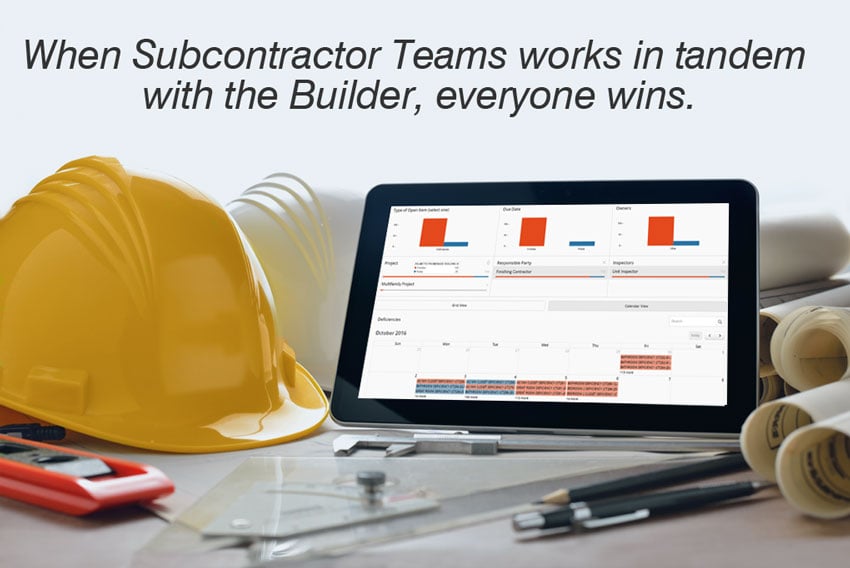🔊Listen to five effective strategies to align subcontractors with your quality control plan and enhance construction project outcomes.

A strong Quality Assurance Program can actually give the mid-size builder a competitive edge over those large builders with deep pockets. Jobsite waste, scheduling errors, rework, dry-runs and call backs get jumbled-up in the rage of volume building, where the race to deliver projects on-time can overwhelm any quality assurance efforts.
It’s actually easier to deliver first time quality (i.e. finishing each milestone in the construction schedule 100% complete and on time) in a smaller business plan.
Indeed, the builder can respond to quality issues and changes more swiftly, implement improvement measures with greater ease, and deliver a quality project with fewer personnel, fewer resources, and fewer mistakes and accidents. However, this is only possible when the subcontractors and crews work as a team with each other and the builder, all while adhering to quality control plans, utilizing a quality control plan template, and integrating a quality management system.
What is Subcontractor Quality Control?
Subcontractor quality control is the process of measuring and controlling the quality of workmanship, materials and services provided by subcontractors in commercial building projects.
Most construction companies should include as part of the quality control plan, a system that identifies, investigates, and responds to problems regarding the quality of the subcontractor's work.
This information will enable the Quality Control Manager to ensure that every subcontractor providing first-time quality work, meeting the project quality requirements, and adhering to industry standards and acceptance criteria, are selected for future construction projects. This, in turn, helps to minimise the risk in the initial phase of the construction plan.
5 Actions to get commitment to your Subcontractor Quality Control Plan
Here are 5 actions the Builder can take to ensure the Subcontractor is a committed ally in the Quality Assurance Program.
#1 – Share Hot Spot Photos
Actively take photos first on the jobsite to generate right and wrong examples of the work being done, and post these photos on inspection checklists for self-inspecting subs or review during QA/QC Tool Box Talks where the subcontractor can see them.
Prior to a crew commencing their work, it is crucial to review the "Hot Spots" and provide printed copies to each team member. It's equally important to furnish the Subcontractor supervisor with copies for their review and integration into their internal team meetings, aligning with the quality plan, execution of quality control activities, and attainment of quality objectives.
#2 – Discuss inspection notes
Onsite project superintendents should be performing inspections during key or problem milestones in the construction plan. Discuss those inspection notes with Crew Leaders—not in an email or on a note left on the jobsite—but face to face.
When you notice a recurring problem, inquire with the crew supervisor about when, where, and how often they encounter it—especially if it appears across multiple work and construction job sites, a common situation for home builders. Encourage them to provide insights on why it's happening. Taking this time is a valuable investment, in line with established quality standards, process controls, and opportunities for process improvements.
#3 – Solicit job readiness issues
Ask the Subcontractors on the jobsite to talk to you about job readiness issues. Make it clear that you want to provide a jobsite that is 100% ready for their crew to work on when they’re scheduled to arrive.
If something is impeding that, whether it's an issue caused by a previous Subcontractor, recurring delays, cleanliness or safety concerns, or something project personnel are responsible for or not addressing, make it clear that you want to know about it and that you intend to incorporate it into the plan. This aligns with the project team's dedication to meeting customer requirements.
#4 – Use Checklists
Create checklists for the Subcontractors to employ. These checklists serve to clearly articulate your expectations for completing the construction job, encompassing the handling of raw materials and conducting quality checks, thereby ensuring adherence to project requirements.
It also helps the Subcontractor by reducing punch list items and eliminating general wasted time and resources in call-backs and return trips. Checklists will keep the construction schedule moving forward and is an integral part of achieving first time quality control.
#5 - Follow-up. Follow-up. Follow-up.
Once a problem has been addressed (whether it's a recurring error, excessive punch lists, jobsite readiness, or callbacks), make it a point for you and your project team to track the progress in the quality control plans, quality control plan template, quality management system, quality plans, and life cycle. Include these aspects in future checklists for comprehensive project management.
This will ask the crew leaders and subcontractors if they’re still seeing the problem occur? Are they seeing the expected general improvements? If so, update the checklists and Hot Spot photos with that improvement.
How to manage subcontractors in construction
![[FREE GUIDE] How to Quickly Improve Your Subcontractors Performance](https://no-cache.hubspot.com/cta/default/3353989/fac47599-fc2e-4c85-89b3-d0fc8a6cb984.png)
